Steven Sandor's Blog, page 117
July 19, 2014
Atlanta gets its first NASL clean sheet of 2014… against FC Edmonton
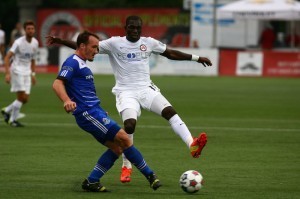
FCE’s Albert Watson tries to keep the ball away from Atlanta’s Kwadwo Poku.
A second-half free kick from Pablo Cruz represented the margin of the Atlanta Silverbacks’ 1-0 victory over FC Edmonton.But, the real culprit Saturday night in Atlanta was the Eddies’ lack of inventiveness or finishing in the final third.
In last week’s 0-0 draw with the Ottawa Fury — a game which saw FCE coach Colin Miller bemoan his team’s lack of intensity — the Eddies could at least boast that they hit the woodwork a couple of times. They didn’t get that close in Atlanta.
It took until the 82nd minute for the Eddies to force Atlanta keeper Joe Nasco into a meaningful save. Just two minutes after coming in as a late sub, FCE teenager Hanson Boakai won a physical battle with Atlanta’s Kwadwo Poku at the top of the box, and then left-footed a curling shot towards the top corner that forced Nasco into a fingertip save. Yes, Nasco had to catch a couple of balls that were directed right at him earlier in the game, but the Boakai effort was the first chance that put the keeper to work.
And all this against a team that, before Saturday, could not boast keeping a clean sheet in NASL action this season.
The Eddies did have a few looks at goal. In the 32nd minute, striker Frank Jonke was able to blow through four defenders up the gut, but, when he had a clear look at goal, he screwed his shot wide. Early in the second half, Kareem Moses had a good luck on a set piece. After the ball was headed across goal by Albert Watson, it fell just out of Moses’s reach.
Horace James, one of three Eddies making a return to Atlanta, had two chances. He headed one over the goal. And, after an Atlanta giveaway, he had the chance to finish a great cross from Eddie Edward, but that side-footed effort went wide, too.
For a team like the Eddies, who have struggled to score goals outside of one six-goal romp against Carolina in the spring season, it’s important for the attackers to at least test the keeper when the chances come. But, at the end of the night against one of the worst defensive teams in NASL, only Boakai could boast that he forced Nasco to work hard.
“I thought Nasco was excellent tonight,” Miller said. “But, I also think that Big Joe could have played for the U.S. national team for the way that we were putting crosses into his hands. It’s frustrating. I think Atlanta had two chances all game long, and they scored on one of them.”
The Eddies, as per usual, were organized and hard to break down. But when the offence can’t produce, the opposition can afford to be patient at 0-0. And, eventually, chances will come.
In the first half, the Silverbacks had one decent look. After a series of a couple of corner kicks, Atlanta forward Junior Sandoval got a look at goal, but his attempt was blocked by Moses.
In the second half, a good cross from Atlanta fullback Mike Randolph allowed forward Jaime Chavez to get inside of Eddies’ centre back Beto Navarro, who was acquired from Atlanta a week ago. That put Chavez in alone on goal, but Eddies’ keeper John Smits was able to come off his line to smother the chance.
It looked like that might be the save that would at least allow FCE to escape Atlanta with a single point. But a free kick from Cruz, struck from just outside the box, eluded him with about 15 minutes left in the match. Smits dove to his right and looked to get his hands to the ball, but didn’t make enough contact to knock it away from goal.
“We had a good look at it and it looked like he got two hands to the ball,” said Miller. “I’ll have to look at it again on TV before I critique it, but it did look like he got his hands there. But that was the difference in the game. He curls a free kick over the wall. It was a poor free kick to give away.”
Silverbacks coach Eric Wynalda, in his last game pulling the strings for the club, said the bench was screaming for Cruz to take the kick after Watson was judged to have fouled Poku just outside the area.
“We were screaming from the bench, he does it so many times in practice.”
Wynalda will remain Atlanta’s technical director, but his TV commentary schedule has become a lot busier, leaving him less time to look after the day-to-day affairs of the Silverbacks.
Milton Blanco, the third former Silverback to find his way to the Eddies, also got into the game as a sub. But for Navarro, Blanco and James, it was a very unhappy return to the Peach State.
And, with two games gone in the fall season, the Eddies have yet to score a goal.
“There isn’t anything more we can do in training,” said Miller. “Day in and day out we put the players in positions where they can score. You see the quality of our attacking in our training sessions, and then we come here and we don’t come away with anything. It is disappointing”
READ PLASTIC PITCH TODAY. SUMMER ISSUE FEATURES A 16-PAGE SECTION ON CANADA’S BID FOR THE 2026 WORLD CUP!
(Also available for Android devices at Google Play)
July 16, 2014
CSA hopeful that Women’s World Cup will spur NWSL to expand to Canada
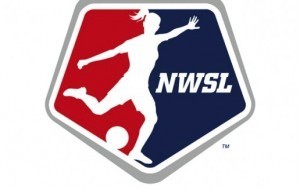 The Canadian Soccer Association funds the salaries of 14 NWSL players this season.
The Canadian Soccer Association funds the salaries of 14 NWSL players this season.
But, the hope is that soon there will actually be a Canadian team in North America’s top women’s soccer circuit. Currently, the Canadian players are spread through nine U.S.-based franchises. Peter Montopoli, the Canadian Soccer Association’s General Secretary, hopes that it will change after Canada hosts the Women’s World Cup in 2015.
“Absolutely. We believe that, after 2015, the interest will be there for at least one city to be a part of NWSL,” said Montopoli. “The interest will merit it…. It certainly presents an opportunity for an owner (in Canada) to be part of NWSL. We have had those initial discussions with NWSL but we’re currently waiting to see the success of 2015 before we get there.”
Montopoli was in Edmonton Wednesday to make a presentation to the city’s Chamber of Commerce. It was interesting to note that, when he explained the CSA’s relationship with NWSL to Edmonton’s business community, he called this country a “partner” in the league, along with the U.S. and Mexican soccer federations. He did not simply say that Canada had the option to pay the salaries of up to 16 players in the league.
(Because of a knee injury to Selenia Iacchelli, and Desiree Scott’s decision to leave NWSL, the CSA is only supporting 14 players in 2014.)
Of course, Montopoli spoke of the need for Edmonton’s soccer fans, business community and casual sports followers to support the upcoming U-20 Women’s World Cup and next year’s Women’s World Cup. Edmonton hosts more games at the Women’s World Cup than any other city, including the opening ceremonies and Canada’s first two group-stage matches. According to estimates he shared with the Chamber, the Women’s World Cup’s economic benefit for Alberta should be nearly $66 million, far more than any other province, including British Columbia, which hosts the final.
He told those at the luncheon that it was important for Edmontonians not just to be there, “but be a sea of red.”
He also said that it was important that at least 1.5 million people attend the 2015 Women’s World Cup matches. Not only would it make the 2015 WWC the most-attended FIFA event outside of a Women’s World Cup, it would also break a major psychological glass ceiling for Canadians. Getting to 1.5 million would make the Women’s World Cup a better-attended event than the 2010 Vancouver Winter Olympics.
“To think that one team sport, one women’s sport, can break the record. It would set the standard for women’s sport in this country.”
As well, he lauded Edmonton for being the birthplace of Canada’s international success — at least when it comes to hosting tournaments. He said that the final of the U-19 Women’s World Championship, held in 2002 at Commonwealth Stadium, set a new standard when 45,000 came out to watch. And that set Canada on a journey that led to the 2007 U-20 World Cup, and the U-20 Women’s World Cup and Women’s World Cup.
But he said that this year’s U-20 Women’s World Cup is much different than the 2002 tourney that wrapped up in Edmonton.
“It’s a different tournament now, because FIFA’s changed. They have many more standards and protocols and, certainly, more staff. And, for us, it’s different because we are literally across the country, from Edmonton to Moncton. It presents some differences in terms of air travel.”
He said that the roster of Canada’s U-20 women’s team, revealed on Wednesday, follows through on the development plan that should produce “more Sinclairs, more often.” (Of course, in reference to Canada’s all-time leading scorer, Christine Sinclair).
“I think we have one or two Sinclairs in there,” said Montopoli.
READ PLASTIC PITCH TODAY. SUMMER ISSUE FEATURES A 16-PAGE SECTION ON CANADA’S BID FOR THE 2026 WORLD CUP!
(Also available for Android devices at Google Play)
Montopoli: Canada has no plans to share World Cup 2026 bid with another nation

Peter Montopoli
The General Secretary of the Canadian Soccer Association made it clear: When Canada bids for the World Cup, it won’t have a dance partner.Peter Montopoli was in Edmonton Wednesday, speaking to the Chamber of Commerce about the coming U-20 Women’s World Cup and the Women’s World Cup in 2015. But the Canadian Soccer Association’s bid for the 2026 World Cup, which is expected to go to FIFA some time in 2016, also came up.
And, when he was asked about the possibility of submitting a shared bid, Montopoli said the answer is no.
“It’s a single bid. It’s Canada, at this moment. It’s Canada, the Canadian Soccer Association that will be bidding, and we will continue along that line. There really have been no discussions on joint bids, either Mexico or the United States. It’s not a position we’re taking. It is a straight bid from the Canadian Soccer Association.”
Montopoli said that getting the 2026 World Cup would complete a journey that began in Edmonton in 2002, when 45,000 fans attended the final of the then-named U-19 Women’s World Championship, a predecessor of the U-20 Women’s World Cup. FIFA officials were startled by the Canadian suppot for women’s youth soccer, and that final put Canada on the road to hosting the U-20 World Cup in 2007, then the U-20 Women’s World Cup this year and the Women’s World Cup in 2015.
“The path of where we are going, in terms of soccer in this country, started in 2002, we’re weaving it through 2015, but I don’t think it’s going to end in 2015. We hope that it goes to 2026. We are planning to put a bid in, we are waiting for the FIFA protocols and all their documents and requirements for a men’s World Cup. We are familiar with it, but, until FIFA lays down the process it’s hard for us to comment on what it looks like.
“But we would like to make a serious bid. We would like to think that FIFA is looking at CONCACAF, our region. If you look at the last number of FIFA World Cups, they have not been in CONCACAF, so is it time for it to come back to CONCACAF? We’d like to think so. And, if it comes back, we will be ready to be the major bidder for 2026.”
The fact that next year’s Women World Cup will feature games spanning the second-largest nation in the world, in five time zones, should ease fears about hosting a World Cup which will require visitors and teams to fly from city to city, rather than take trains or buses. As well, a lot will be learned from the 2018 World Cup, which will be held in the world’s largest country by landmass, Russia.
“We will learn that from Russia,” said Montopoli. “We will learn how they are planning that and FIFA will learn from that, as well. Interestingly, Germany, in 2011 (Women’s World Cup) had one time zone. They bused every team to every match. We are pretty well flying teams to every match. People just don’t see from an organizational perspective how expensive it is for us to be doing something like this as opposed to a European country that gets a competition and hosts it and run it. I don’t want to say it’s simple; it’s not simple. But the logistically it’s much easier when you are within a car ride, a couple of hours, of all these venues. We’re not. We’re four hours, four and a half hours, by air, to get from Ottawa to Edmonton. But we’re used to being faced with the impossible in Canada. We say we’re going to do it, and we’ll do it well.”
READ PLASTIC PITCH TODAY. SUMMER ISSUE FEATURES A 16-PAGE SECTION ON CANADA’S BID FOR THE 2026 WORLD CUP!
(Also available for Android devices at Google Play)
Beckie’s move from American program to Canadian program highlights U-20 roster
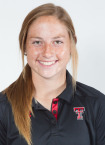
Janine Beckie
Over the past two NCAA seasons, Janine Beckie has scored at a torrid pace for Texas Tech.Now, her addition to the Canadian team ahead of the U-20 Women’s World Cup provides coach Andrew Olivieri with an interesting trump card.
Beckie’s name was on the team roster for the U-20 Women’s World Cup, which was announced Wednesday morning. And Beckie, a former member of the American youth program who joined the Canadian system earlier this year, was on it.
And, yes, before you even need to ask — she is the sister of defender Drew Beckie, the current Ottawa Fury member who played with Canada’s U-23s in qualifying games for the 2012 World Cup. In fact, U-20 Women’s Team coach Andrew Olivieri said that Drew’s input was key in helping his sister decide to play for Canada.
Both Drew and Janine were born in Saskatchewan, but their family moved to Colorado when they were young.
But, with Nichelle Prince scoring 12 goals in 19 games for Ohio State, and Beckie scoring 26 times in 45 career games for Texas Tech, the side has some interesting offensive options.
I spoke with Olivieri about Beckie’s move from the U.S. program to the Canadian program, part of the U-20 Women’s World Cup preview you can find in the new issue of Inside Soccer.
CANADA
1- GK – Kailen Sheridan | USA / Clemson University
2- D – Sura Yekka | CAN / Brams United
3- D – Kinley McNicoll | USA / University of Wisconsin
4- D – Kylie Davis | CAN / Comètes de Laval
5- D – Kadeisha Buchanan | CAN / Ottawa Fury FC
6- D – Rebecca Quinn | USA / Duke University
7- M – Ashley Campbell | CAN / Toronto Lady Lynx
8- M – Jessie Fleming | CAN / London NorWest SC
9- F – Nichelle Prince | CAN / Toronto Lady Lynx
10- M -Ashley Lawrence | CAN / Ottawa Fury FC
11- F – Janine Beckie | USA / Texas Tech University
12- D – Victoria Pickett | CAN / Glen Shields
13- D – Lindsay Agnew | USA / The Ohio State University
14- M – Vanessa Grégoire | CAN / Comètes de Laval
15- D – Jordane Carvery | CAN / Glen Shields
16- M – Sarah Kinzner | CAN / Calgary Foothills
17- F – Amandine Pierre-Louis | CAN / Comètes de Laval
18- GK – Marie-Joëlle Vandal | CAN / Dynamo de Québec
19- F – Valérie Sanderson | CAN / Comètes de Laval
20- M – Emma Fletcher | USA / Louisiana State University
21- GK – Rylee Foster | CAN / Woodbridge SC
July 15, 2014
Garber hints that Canadian-player rules in MLS may change: Why we need to look at minutes played, not roster spots
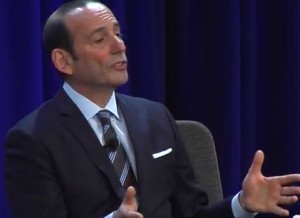
Don Garber
In a Facebook chat with fans held on Monday, MLS Commissioner Don Garber was greeted with the thorny question about Canadian players in the league.Francis Ghanimé asked him: “Will Canadian players ever stop counting as internationals for American clubs?”
And this was the answer from the commish.
“We are working on a new approach to our international player rules as they relate to Canada. Stay tuned.”
We have asked MLS for more clarification on the issue.
But, we do know the rules as they pertain to Canadians are on the radar. We also know the Canadian Soccer Association has lobbied MLS to changes the rules so Canadians are seen as domestic players, league wide. This would then put MLS on an equal footing with USL-PRO, which allows Canadians to be domestics on U.S. clubs.
Right now, the Canadian teams are required to each carry three Canadian players on their rosters. On the U.S. teams, Canadians are counted as international players and take up roster space that many American teams would prefer to give to players from, well, sexier parts of the soccer world. Meanwhile, on Canadian teams, Americans are seen as domestics.
The timing is interesting. We know CSA has been pushing for changes for a while. But, now, the CSA has gone public with its stated goal of having Canada’s own “Division 1A” (CLICK HERE or see issue 2 of Plastic Pitch), and reports continue that NASL, CFL owners and the CSA are discussing the formation of a Canadian division — something that NASL won’t deny, but says it simply can’t comment on… at this time.
So, pressure is no doubt building on MLS.
As we discussed in “The Law of Diminishing Returns” feature in the first issue of Plastic Pitch (see the end of the article on how to find issues 1 and 2 of the magazine), in the 2013 MLS season, Canadian players got an average of 1025.2 minutes per team. That works out to just a little more than 11 full games.
In 1996, the league’s debut season, Canadian players averaged 946.7 minutes per team. That’s an average of a little more than 10 full games.
Yes, the number of teams has nearly doubled since 1996. So, you can argue that, in total, there are more roster spots available for Canadians. But, with the addition of three Canadian franchises, you’d think the minutes-played average would have skyrocketed. But it hasn’t.
Clearly, the system isn’t working.
We spent thousands of words (with charts!) on the minutes-played in MLS piece. It’s all there.
But what did we prove? That roster spots shouldn’t be an end goal to itself. As MLS rosters become larger, it’s becoming a lot easier to bury players at the end of the bench. Over the last couple of years, when it comes to Canadians MLS teams, we’ve seen players who don’t get a minute of first-team action.
That was the case with Drew Beckie with the Columbus Crew in 2013; even though injuries and a coaching change with the Crew did play their roles. Babayele Sodade was released by the Seattle Sounders in 2013 after being drafted by the club in 2012. An ACL tear curtailed his progress, and the Sounders felt it would be better for him to find a new club. Evan James spent the 2012 season with the Montreal Impact, didn’t play a game, and was released. Philippe Davies spent all of the Vancouver Whitecaps’ inaugural MLS season on the roster, didn’t play a game.
And there are some who come close to never seeing time. Emery Welshman had one appearance for TFC in 2013, spent the season with the Reds, and was released. Last year, Kyle Bekker played more minutes with the Canadian national team than he did for Toronto FC.
So, you can give Canadians more roster spots; but you need to back it up with a meaningful goal. And that’s first-team minutes.
So, as MLS looks to tweaking or making major changes to the international rule as it relates to Canadians, the Canadian Soccer Association and the league need to set a goal that’s more cut-and-dried than giving more roster spots or even, gasp, dropping the Canadians-as-internationals-on-American-teams designation. Someone needs to write down a number. And that number would be a ballpark average of first-team minutes for Canadians.
Sure, you can’t guarantee time. Some players will be pushed to the bench for competitive reasons. Others will get injured. But, even with those variable, saying that we’d like to see the Canadian minutes, on average, move to 2,000 per team would be a reachable goal.
It would represent double the playing minutes Canadians are getting right now, but would still represent a total of just a touch more than 22 games of playing time per team. If anything, the modest goal shows just how badly the current system is serving the development of Canadian soccer.
In the end, it’s a question of if we see MLS as a developmental league or not. It surely is a chameleon, isn’t it? It has a stated goal of being a world-class league by 2020, which should mean the influx of more international players, but also ties itself closely to the success of the U.S. national team. It still conducts an amateur draft, even though world-class soccer leagues don’t control youth talent in that fashion — nor do world-class soccer clubs trust schools to teach their young players how to play the game.
So, as long as a draft exists, as long as American players are given protection on Canadian rosters, it is absolutely fair to see MLS as a developmental league — and therefore expecting something as small as a 2,000-minute Canadian player average shouldn’t be onerous to MLS at all.
And, by calling for a league-wide average on minutes, you might find a loophole in the U.S. labour laws MLS has cited in preventing Canadians as domestics in American markets. USL-PRO does see Canadians as domestics, and sources have told us that this is more of a USSF issue than a true labour-law issue. The prejudicial nature of sports rosters makes them difficult targets for labour law; if we did apply labour law strictly to rosters, you could argue that the veteran who gets cut to make way for the rookie could sue the team or league. He is being replaced by a cheaper worker who doesn’t have anywhere close to the same kind of résumé.
In Canada, we have watched MLS evolve in this country since 2007. It has coincided with a deep funk for our national men’s team. In the early ‘90s, we still made it to the hex. We got to playoff games with other confederations. Now, we crash out in the early stages of CONCACAF qualifying. Our players see no minutes.
But, the problem also exists at the front-office level for MLS. MLS lists 12 major executives (CLICK HERE). How many are Canadians? None. Considering that this league has had Canadian members since 2007, and now has three of 19 teams in this country, it’s amazing to see that there still isn’t a vice-president who is from Canada and has an “I grew up with it” understanding of the game in this country. That’s another issue MLS must address. At the executive level, it needs a Canadian. And, getting around labour laws in that case is easy. Rent an office in Toronto or Montreal or Vancouver if you’re worried about that. In fact, it might just be the PR move the league needs, to have a dedicated vice-president for Canada, who deals with Canadian soccer issues and acts as the voice for the league in this country.
WORLD CUP 2026 IN CANADA? OUR OWN DIVISION 1A? READ PLASTIC PITCH TODAY.
(Also available for Android devices at Google Play)
ALSO:
SEE The fine lines: Labour law, competitive balance, Canadians and MLS (CLICK HERE)
AND
The MLS “domestic” rule: Why allowing more Canadians in wouldn’t run afoul of U.S. Immigration (CLICK HERE)
July 13, 2014
FC Edmonton likely to boost number of Fort McMurray “home” games in 2015
 FC Edmonton announced earlier this year that it would be playing an NASL match in Fort McMurray in the 2015 season.
FC Edmonton announced earlier this year that it would be playing an NASL match in Fort McMurray in the 2015 season.
Now, the team says that it’s likely that two or three league games will be played in Canada’s oil-sands territory next season.
Because Edmonton hosts more games than any other city at next year’s Women’s World Cup, Clarke Stadium won’t be available for six weeks, through June and into the first week of July. Clarke Stadium is adjacent to Commonwealth Stadium, and wouldn’t be available when FIFA takes over the site.
The number of games FCE would play in Fort Mac would depend on when the NASL schedules its break between the spring and fall seasons. But, as of right now, the team has indicated that it looks like at least two dates in June could go to Fort Mac. That could go as high as three.
The league does not want to put FCE on a six-game road trip (again, depending on the break) when the Women’s World Cup comes to Canada. Of course, the WWC also brings up issues for the Ottawa Fury and its stadium, TD Place.
But, after talking to FCE’s brass today, it’s clear that there isn’t much fretting about needing to go up to Fort McMurray, which is 435 km northeast of the capital. Fort McMurray gives the team access to some of the most powerful potential sponsors in the country. And getting soccer onto the radar of Canada’s oil producers could be a major coup for the NASL and for the game in this country. But to get soccer onto the radar of the oil sector, you need to bring the pro game to its backyard.
According to the Canadian Association of Petroleum Producers, the oil sands produce 885,000 barrels of oil per day, and the revenue generated by the industry was nearly $50 billion per year. It’s an industry that badly needs to improve its image, and what better way than to promote the improvement of soccer in Canada? It would serve the likes of Suncor and Syncrude so much more to get behind sport than it would to try ad campaigns that don’t change opinions of oil-sands opponents.
There are direct flights from Denver to Fort McMurray, so the games shouldn’t pose too much of an issue for the road team.
WORLD CUP 2026 IN CANADA? OUR OWN DIVISION 1A? READ PLASTIC PITCH TODAY.
(Also available for Android devices at Google Play)
Helter swelter: Miller fumes after FCE can’t take advantage of 10-man Fury
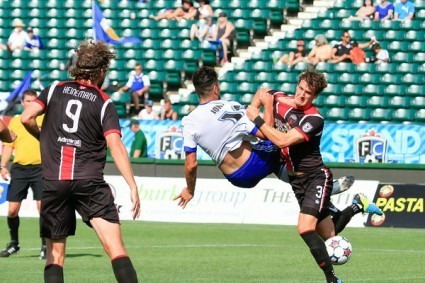
Ottawa’s Mason Trafford brings down FCE’s Frank Jonke at Commonwealth Stadium. PHOTO: TONY LEWIS
Memo to FC Edmonton players: Tuesday’s training session is going to be a hellish one, indeed.Coach Colin Miller promised that his players would be doing a lot of running at that training session after the Eddies laboured to a 0-0 draw with the Ottawa Fury at Commonwealth Stadium. The Eddies went up a man in the 56th minute after Ryan Richter, making his Fury debut after being loaned out from Toronto FC, was sent off.
But it wasn’t till late in the game that the Eddies were able to create any real chances. In the 87th, Hanson Boakai had a shot deflect off the foot of Fury defender Mason Trafford and strike the post. Then, in time added on, Horace James’s header off a corner kick also hit the woodwork.
You could argue that the posts were a sign of bad luck, but Miller wasn’t buying it. He was furious at his team for being offensively ineffective, especially with more than 30 minutes of playing time with a man advantage.
“This is the angriest I’ve been since I’ve been at FC Edmonton,” Miller said.
Most of the game was played at well less than normal speed, as the pitch side temperatures hit 35 C, before the humidity was factored in. On a brilliant, sunny day in Edmonton, Environment Canada had the game time temperature at 26 C. But, artificial turf and its rubber pellets have a tendency to absorb and reflect heat. So, at pitch side, the turf added nearly 10 C to the temperature, making for a sweltering slog in hellish conditions.
“The heat was a major factor,” said Ottawa coach Marc Dos Santos. “The one quality both of these teams have is their intensity, and the heat took that away a bit.”
There was only one real chance of note in the first half; Beto Navarro, making his debut at centre back for the Eddies after being acquired Saturday from Atlanta, collided with Trafford on an Ottawa free kick in the box. Both Navarro and Trafford pushed back into FCE keeper John Smits. Meanwhile, the ball skidded away and rolled off the post. Navarro was able to get up and scramble it away.
Navarro wasn’t the only Eddie making his debut with the club. Midfielder Cristian Raudales also got a start.
At halftime, our FCETV crew had to deal with field-side microphones which had broken down in the heat. In the truck, the air conditioning failed and the production crew had fans blowing over ice laid on the floor. Still, the temps in the truck got to over 40 C, and warning beeps were coming from many of the components.
But, in the 56th, it looked as if Edmonton would be able to use the heat to its advantage. Richter, already on a yellow for fouling Frank Jonke in the first half, misplayed a ball off his chest and then off his leg. Because Richter lost control, Jonke tried to pounce on the loose ball. Richter reached across Jonke to hold him back — and got a second yellow for it.
Dos Santos said his team then knew that it would need to grind out the final 30-plus minutes to try and escape with the draw.
“We knew that we had to suffer, and we did suffer.”
While Dos Santos said the heat was a major factor, Miller wouldn’t have it. He was frustrated that the Eddies didn’t really show any life till Boakai came in as a late sub. He pointed to this weekend’s MLS action, with Chivas taking advantage of a 10-man Whitecaps side, winning 3-1.
“It’s en excuse. I’ve played in heat. It’s about playing with passion, about wanting it more. Ottawa didn’t create anything, they were trying to kill the clock. But it took until we put in a 17-year-old for us to create anything. Look at the Chivas game vs. Vancouver last night, Chivas won because they wanted it more.”
Now, Miller will likely turn up the heat in training.
Attendance for the game was announced at 3,609, but it certainly didn’t look like that many fans had made it to Commonwealth to suffer in the heat, in a game that kicked off just 15 minutes after Germany had won the World Cup. Hopefully the team and league will learn that nothing should try and compete with the World Cup. Even though the FCE game kicked off three hours after the World Cup final kicked off, there was still too much overlap.
FCE had to play this game at the 56,000-seat Commonwealth Stadium because the installation of the new turf at Clarke Stadium, the team’s regular home, was not yet complete.
WORLD CUP 2026 IN CANADA? OUR OWN DIVISION 1A? READ PLASTIC PITCH TODAY.
(Also available for Android devices at Google Play)
July 12, 2014
Defender Beto Navarro joins FC Edmonton
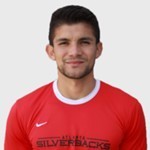
Beto Navarro
In 2013, the Atlanta Silverbacks shocked the NASL by winning the spring season title and earning the right to host the Soccer Bowl.Now that defender Beto Navarro has joined FC Edmonton, that makes three members of that Silverbacks team who are now Eddies. Midfielders Milton Blanco and Horace James joined the Eddies at the start of the season. Navarro, a centre back, has been acquired by the Eddies just in time to be eligible to play in Sunday’s fall-season opener against the Ottawa Fury.
Navarro started in last year’s Soccer Bowl, after playing 25 games in the regular season for a total of 2222 minutes played.
Navarro played in three league games for the Silverbacks in the 2014 spring season, but also appeared in four U.S. Open Cup matches.
The Eddies have confirmed that Navarro was acquired via transfer, but would not say how much was paid to the Silverbacks for the defender.
The Eddies now have made three additions to the club during the NASL’s hiatus: Navarro joins midfielder Cristian Raudales and forward Chad Burt, whose deal was made official on Friday.
WORLD CUP 2026 IN CANADA? OUR OWN DIVISION 1A? READ PLASTIC PITCH TODAY.
(Also available for Android devices at Google Play)
July 10, 2014
Raudales could be a “steal,” while Eddies look to add a couple of more players
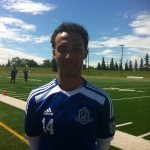
Cristian Raudales
It is the job of FC Edmonton assistant coach Jeff Paulus to sort through the emails and videos sent to the team by players and their agents. The wide majority don’t result in call-backs.But there was something in the material sent by Cristian Raudales that intrigued Paulus. That resulted in an invite to the Eddies’ midseason training camp. Raudales scored last week in a friendly against the Seattle Sounders, and was signed this week.
The Honduran-American, who is from Florida, is one of three signings expected to be made by the Eddies before the NASL fall season begins for the team on Sunday. It is understood that forward Chad Burt, also on trial, is close to a deal. And coach Colin Miller said another player will arrive tomorrow — and Miller is so bullish on this prospect, he hinted that he could play on Sunday.
But he also really likes what he’s seen from Raudales.
“I think we have made a real steal of a player.”
Raudales is a graduate of Florida Gulf Coast University, then played for a season in the German fourth division. Being from Florida, he said he knows the NASL well — as the league has two teams in the state and a third one on the way. (And maybe a fourth, as the league has said it has talked with a group in Miami.)
Raudales describes himself as a player that can “destroy” the opposition’s attacks and help his team build its offensive forays.
“I would say that I am a workhorse kind of player. I may not score a whole lot of goals, but I will do my part in midfield.”
He said that he fit in as soon as he put on the Eddies’ shirt as a trialist.
“I played with Neil Hlavaty in central midfield, and he’s so good on the ball. I really felt like I’d been playing with the guys for a long time.”
WORLD CUP 2026 IN CANADA? OUR OWN DIVISION 1A? READ PLASTIC PITCH TODAY.
(Also available for Android devices at Google Play)
NASL Commissioner talks about Canada’s long-term plans, expansion and league format
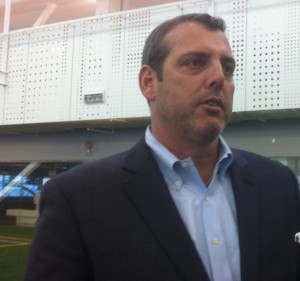
Bill Peterson
NASL Commissioner Bill Peterson says his league is looking closely at one unnamed Canadian market as an expansion candidate, and is supportive of the long-term goals of the Canadian Soccer Association.In a state-of-the-NASL conference call held Thursday morning, Peterson said he would be talking with CSA officials later in the day to discuss the organization’s long-term vision for the game in Canada. And he said the NASL would support the CSA’s vision, even if it includes the eventual launch of a Canadian Division “1A” league.
“We will have discussions with the CSA looking at the long-term future, what it looks like,” Peterson said. “We are open and supportive to what the long-term goals are going to be.”
CSA president Victor Montagliani, in an interview with Plastic Pitch(see the end of the post for subscription details on how to get the magazine), said that a long-term goal for the organization would be a Canadian only Division 1, which would “coexist” with MLS and NASL. It would not be directly tied to Canada’s bid for the 2026 World Cup, and investors would need to be found.
Peterson said that NASL will add more Canadian markets — adding to teams already in Edmonton and Ottawa. And he’s interested to see what that means for the future, and how it fits into the CSA’s vision. He called the CSA a “great partner.”
He said “what’s good for soccer in North America” is good for his league.
Peterson was a little more cautious in talking about Canada’s bid for the 2026 World Cup. That’s understandable, as just two of the league’s 10 teams are in Canada. And, while the United States has said it won’t bid for 2026 unless FIFA becomes more transparent, that possibility is still out there, especially with the buzz over the U.S. national team from this World Cup. So, no league would want to get caught in the middle at this stage.
Peterson said a World Cup bid is “federation level issue,” but said he does want to see the tournament return to North America.
“We are a North American league, so we would support any bid from North America, to the extent that we can.”
OTTAWA RECORD?
Peterson said he can’t wait for the July 20 match between the Ottawa Fury and the New York Cosmos, which will mark the first time NASL soccer will be played in the new TD Place.
The stadium is ready for the NASL fall season and the 2014 CFL campaign. And Peterson believes the response from the nation’s capital will set a new standard for the league.
“I suspect they’ll set an NASL attendance record (for a single game). The response has been quite incredible.”
FORMAT
This year, the league tweaked its split season format.
Because the NASL did not want to play against the majority of the World Cup (and we say “majority” because FC Edmonton and Ottawa play on the same day as the World Cup final), the league adopted an imbalanced split season. The spring season saw each of the 10 teams play a nine-game schedule. Meanwhile, in the fall, the teams will each play an 18-game schedule.
The fall and spring season champions will host the first round of post-season games. The teams with the best overall records who weren’t either spring or fall champs will take the Nos. 3 and 4 seeds and be the road teams for those post-season matches. The winners of those games will play for the Soccer Bowl.
But, there has been criticism of a system which will see the fall season be twice as long as the spring season was.
As the league continues to expand, the format should work itself out. The stated goal of NASL is to have 18-20 teams by 2018.
“The ultimate goal is to have 20 teams on a single table, playing a balanced schedule,” said Peterson. But he said the single-table, balanced format won’t be workable till the league gets to at least 16 teams.
And, to complicate matters, North American soccer fans will have the Gold Cup to watch next summer. Then the special centennial edition of the Copa America, which includes CONCACAF teams along with the South American powers playing on American soil, in 2016. So, timing-wise, the same kind of NASL format could be used for 2015 and 2016 that is being used this season.
Peterson said the short spring-extended fall setup is one of three formats the league is looking at, and it will be discussed in an upcoming call with the league’s coaches.
EXPANSION
On top of the unnamed Canadian city, which Peterson said has an engaged ownership group, two more expansion possibilities were discussed: Miami and Hartford.
Peterson said he has spoken with Hartford’s mayor, and he is excited about the market. He said the city wants to accommodate a pro soccer franchise. But the elephant in the room is a committed ownership group. That’s the piece that still needs to be worked out.
As for Miami, Peterson said there is an ownership group interested in putting a team in the city where David Beckham can’t seem to get an MLS stadium built.
Even though there’s already a team in Fort Lauderdale, Peterson said he didn’t think they conflicted outside of the fact they share a TV market. He said the league saw them as two markets that could support two teams.
If the NASL would take plunge into Miami, it would have that team, Fort Lauderdale Strikers, Tampa Bay Rowdies and Jacksonville Armada — joining the league next year — to cover the state of Florida.
Despite the talk about Miami and Hartford, Peterson said the priority for the league remains expansion into the west.
WORLD CUP 2026 IN CANADA? OUR OWN DIVISION 1A? READ PLASTIC PITCH TODAY.
(Also available for Android devices at Google Play)




